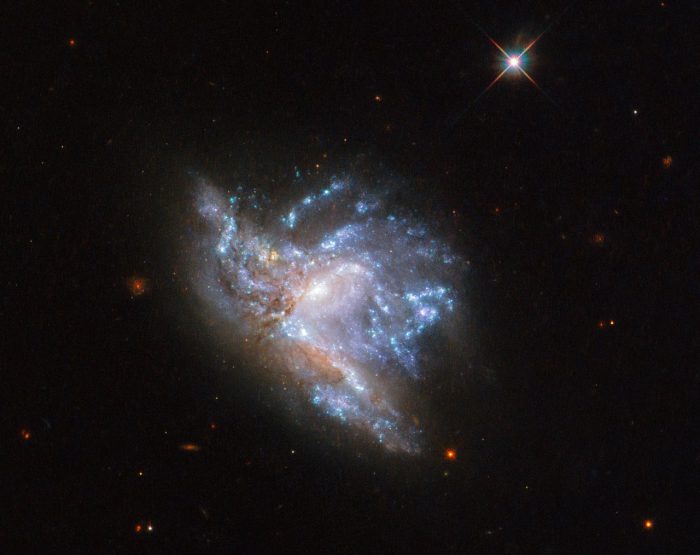The universe—and everything in it—is on the move.
Planet Earth? It's rotating at around 1,000 km/h (600 mph), while orbiting at 108,000 km/h (70,000 mph).
The Sun? It's going even faster, orbiting around the black hole at the centre of our galaxy, the Milky Way, at something around 720,000 km/h (450,000 mph).
And our galaxy? It's flying through space at phenomenal speeds. One day, in fact, scientists predict that it will actual collide with another spiral galaxy, Andromeda. Wait. What?
It's okay, it's okay! By "one day" scientists mean over four billion years from now.
Haha, yeah! But you know, now that we don't have to be so freaked out, it does make you wonder... Two colliding galaxies. What might that look like?
Crash! Big Bang! Boom!
To be fair, we kind of spoiled the surprise on this one: the image it at the top of this post! But here it is again anyway.

Can you pick out the axis—or rotation angles—of the two original galaxies in this photo? (ESA/NASA/Hubble)
This is a photo of NGC 6052 taken by NASA's Hubble Telescope. It is a pair of spiral galaxies located 230 million light-years from Earth that are in the midst of colliding with each other. In a nutshell, the immense gravity of these two galaxies drew them toward each other. Inevitably, they collided, which was, of course, a disaster.
Collision? Or cosmic cuddle?
That's the thing about two galaxies colliding. It sure sounds like a disaster. And don't get us wrong, neither of those two galaxies will ever be the same.
But all galaxies—including our own—are mostly empty space. This means that there is plenty of, um, space available to accommodate new neighbours. In other words, it is quite unlikely that this coming together has resulted in many actual explosive collisions between stars and planets. Instead, the contents of these galaxies have just folded into each other, like a bowl of cosmic cake batter.
Eventually, this mass of stars will settle, becoming a brand new single super galaxy. Cool!
Sounds like life in the Milky Andromeda Way four billion years from now might be pretty sweet after all!
 NGC 6052 is a pair of colliding spiral galaxies about 230 million light-years from Earth. (ESA/NASA/Hubble)
NGC 6052 is a pair of colliding spiral galaxies about 230 million light-years from Earth. (ESA/NASA/Hubble)









